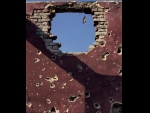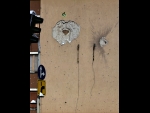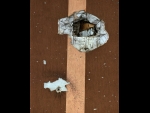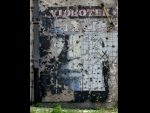Holes : Sarajevo, Mostar, Sisak, Sunja
1996 - 1997

少年の頃、中野区の哲学堂近くの古めかしい水道タンク丸いドームに小さな穴が斜めに5個ほどあいているのを見た事があった。父が「それは太平洋戦争当時の米空母艦載機グラマン・ヘルキャットの12.5ミリ機銃掃射の穴だよ」と教えてくれた。すごく怖かった。私の初めての戦争体験だった。ニュースでサラエボの無数の弾痕を見たとき、私はこれらを撮らねばならないという衝動に駆られた。現実の戦渦の悲惨さとファインダーに逆さに映る奇妙な美しさとの落差に戸惑いながらの撮影だった。戦争で亡くなった方々の冥福を祈りたい。
新しい「HOLES」が創られる事がない事を願わずにはいられない。
平野正樹
When I was young, I saw five small holes in a line across the dome of an old water tank near Tetsugakudo Park in Nakano, Tokyo. My father told me, "Those are bullet holes made by 12.5 mm guns on the Grumman F6F Hellcat which flew from U.S. ships in the Pacific War."
I was very scared. This was my first experience of war.
I visited the former Yugoslavia three times in 1993, 1996 and 1997. i was drawn by the strange beauty of the HOLES I saw in my viewfinder, vestiges of the greatest of human evils. But at the same time, I hesitated over whether it was acceptable for me, as a human being, to take these photographs. I was in constant conflict over this question.
While shooting these photographs, I had many ex-Yugoslavs look through my viewfinder. I told them, "These photographs are not necessary for us today. But I am certain that they will be important for our children and grandchildren." They usually shrugged, but they never asked me to stop. I thank them for this. And I pray that the souls of those who die in the war may rest in peace.
Now having taken these pictures, I realize the obvious: the only difference is that the war in Bosnia and Herzegovina (Sarajevo, Mostar, etc.) ended not so long ago, while the war in Japan ended some fifty years ago. I can but wish that no new HOLES are ever made again.
Masaki HIrano








